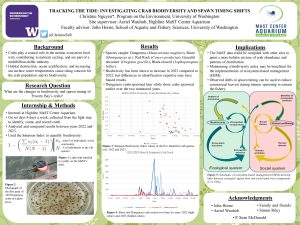TRACKING THE TIDE: INVESTIGATING CRAB BIODIVERSITY AND SPAWN TIMING SHIFTS
Climate change has posed numerous challenges and effects on various aspects of the planet’s ecosystem, which we believe may significantly impact the crab population. Crabs play a crucial role in the marine ecosystem by serving as both predators and prey, contributing to nutrient cycling, and influencing the structure and stability of coastal habitats. Their economic value and contribution to providing people with jobs and food are significant, therefore, understanding the status of these crustaceans will be essential for the scientific community, fisheries, and environmental organizations for management. The aim of this study was to assess changes in crab biodiversity and spawn timing of Poverty Bay from the Highline MaST Center Aquarium’s previous two years of data. On set weekdays four days a week, data was collected from the aquarium’s light trap each day to identify, count, and record when, how many crabs, and the kind of crabs we caught. This is then graphed with data visualizations to infer possible trends with the current and previous years’ data to see any changes in biodiversity and spawn timing. It was found that biodiversity may have increased but requires a larger collection of data for accuracy and credibility in differences in identification expertise. Dungeness crabs have been observed to possibly have a change in later spawn timing with the opposite for shore crabs. Biodiversity data may be useful for ecosystem-based management while spawn timing will help commercial fisheries and environmental firms adapt and respond to established policies accordingly.
